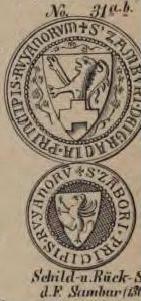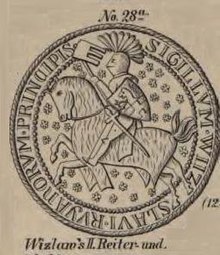Wizlaw II.




Wizlaw II (* around 1240 ; † December 29, 1302 in Oslo ) was a prince of Rügen .
Life
Wizlaw was probably born between 1240 and 1245 as the son of the Rügen prince Jaromar II and Euphemia, daughter of Duke Swantopolk II of Pomerania . After his father, who in Denmark in battles between the Danish royal family and the former Archdiocese of Lund had taken on the part of the church, had been stabbed to death in 1260 in revenge of a woman who was Wizlaw reigning prince of Rügen.
Since the beginning of his rule, Wizlaw II had good relations with the Hanseatic city of Lübeck , whose merchants he had exempted from customs duties within his principality, and in 1266 he renewed the existing trade agreements. He accommodated the city of Stralsund , which was under his rule , by withdrawing the rights to the city of Schadegard, which he built in the immediate vicinity of Stralsund, in 1269 and giving up the city founded to compete with Stralsund.
Probably through claims to the marriage property of his mother, a daughter of Duke Swantopolk II of Pomerania, he came into the pledge possession of the country of Schlawe in 1270 . Possibly in the same year, but no later than 1271, he founded Rügenwalde . In 1277, however, he sold his liens on the Schlawer- and Rügenwalderland to the Brandenburg margraves Johann II , Otto IV and Konrad I , after being ousted from these countries by Duke Mestwin II in 1275 .
On June 13, 1283 the cities of Lübeck, Wismar , Rostock , Stralsund, Greifswald, Stettin , Demmin , Anklam decided together with Duke Johann I of Saxony-Lauenburg , the Mecklenburg dukes, Bogislaw IV of Pomerania and Wizlaw II of Rügen the Rostock Peace Alliance . This alliance was clearly directed against Brandenburg.
In 1283, Wizlaw II received his land from the German King Rudolf I of Habsburg as a German fief, the document probably only related to the continental part. The Rügisch-Danish feudal relationship continued to exist, as the regular participation of Wizlaw II in Danish court days and his mention as a witness in royal Danish documents show. Among other things, he was present at the investigation into the murder of the Danish King Erik Klipping .
In 1285 he confirmed Tribsees city rights. In 1290 the city of Stralsund received the right to catch herring on Wittow and the trade monopoly on the island of Rügen, which in the next few centuries significantly hampered the development of trade and industry, including the grain trade. Greifswald received the saltworks in 1288 and in 1297 the right to build a port in Wieck at the mouth of the Ryck. He expanded the possessions of the monasteries Eldena and Neuenkamp in the principality .
In a contract dated March 12, 1289 (or 1292) with the Margraves of Brandenburg, he pursued the goal of dividing Pomerania between Brandenburg and Rügen after the expected death of Duke Mestwin II. The project failed because of Mestwin II's turn to his Greater Poland neighbors.
Wizlaw II was present on September 29, 1302 at the meeting of the Norwegian King Håkon V with the Swedish King Birger , his brother, Duke Erik , and the Danish Count Jacob von Halland. The meeting took place in Solberga, north of today's Gothenburg . In the same year, possibly immediately after the meeting, Wizlaw II traveled to Norway , where he celebrated Christmas in Oslo with his daughter Euphemia, his daughter Sofia, his sons Wizlaw and Sambor and other relatives. During the celebration, he fell ill and was compelled to make his will on December 27th. He died two days later and was buried in Oslo.
Bones of Wizlaw II.
The grave of Wizlaw II was in St. Mary's Church in Oslo . This was destroyed by fire and looting in the 16th century. It was not until 1868 that the remains of the building were rediscovered. During archaeological excavations, three graves were discovered in the area of the choir. One contained the skeleton of an elderly man who was believed to be a clergyman because of a finger ring. It was included as the prelate in the anthropological collection of the Anatomical Institute of Christiania University . Today it is assumed that it is most likely the remains of Wizlaw II, because he was the only foreign prince buried in Norway.
From measurements of the long bone lengths , a height of 183 cm was derived, unusually tall during Wizlaw II's lifetime. The person was very muscular, especially the muscles needed for running were likely to be well developed. Other features, such as limescale deposits, suggest that Wizlaw mainly moved on foot and did not ride much. Traces of two inflammations on the leg bones are likely due to blunt blows, but seem to have hardly affected the person. Harris lines , which were discovered in x-rays of the shins , indicate two periods of illness with immobility in the 15th and 16th years, about which nothing more is known.
During the excavations in 1868, the remains of a brass grave slab were also found, on which the face of a man with a full beard and curly hair can still be seen. What is striking is the similarity with a grave slab from 1357 that was installed in the Nikolaikirche in Stralsund for Albrecht Hövener. A piece of the grave slab shows the image of chain armor that at that time was only worn by princes and nobles.
progeny
Between 1263 and 1269 Wizlaw II married Agnes von Braunschweig-Lüneburg, the daughter of Duke Otto I , the child of Braunschweig and Mathilde von Brandenburg . The names of four sons and four daughters are known from Wizlaw's will of December 27, 1302:
- Wizlaw III. von Rügen, from 1286 co-regent
- Jaromar (* around 1267; † 1294), rector at the Stralsund Nikolaikirche , after 1288 to 1294 Bishop of Cammin
- Euphemia von Rügen (* around 1280, † 1321), married to King Hakon V of Norway
- Sambor (* around 1267; † June 4, 1304), from 1302 co-regent Wizlaw III., Was probably killed in fighting in Western Pomerania
- Margarete (* around 1270/71; † 1318), married in 1284 to Duke Bogislaw IV of Pommern-Wolgast
- Swantepolk (* around 1273, † after 1285)
- Helena (* around 1271 - † August 9, 1315), married to
- 1288 Prince Johann III. from Mecklenburg,
- 1299 Prince Bernhard II of Anhalt-Bernburg
- Sophia (* around 1281; † after 1302), only mentioned in the will, lived with Euphemia in Norway
literature
- Theodor Pyl : Wizlaw II. Rügen . In: Allgemeine Deutsche Biographie (ADB). Volume 43, Duncker & Humblot, Leipzig 1898, pp. 681-684.
- Joachim Wächter : The Principality of Rügen. An overview. In: Haik Thomas Porada (ed.): Contributions to the history of Western Pomerania. The Demminer Colloquia 1985–1994. Thomas Helms, Schwerin 1997, ISBN 3-931185-11-7 , pp. 299-313.
- Per Holck: The Rügen prince Witzlaw II and his grave in Oslo . In: Society for Pomeranian History and Archeology (Hrsg): Baltic studies . New series, Vol. 87, NG Elwert, Marburg 2001, pp. 36–45 ( digital copy ).
Remarks
- ↑ a b The assumption that Euphemia was a daughter of Count Günther von Arnstein-Lindow-Ruppin is based, according to Ursula Scheil, on a mix-up and was refuted by her in the genealogy of the Princes of Rügen ; (1164 - 1325), Greifswald 1945, but has been refuted still widely used today.
Web links
- The children of Jaromars II. And the children of Wizlaw II. On the homepage of Jens Ruge The Wizlawiden - the Slavic dynasty of Rügen .
- Stefanie Würth : Euphemia: German client of Swedish literature at the Norwegian court , Tübingen 2002 ( PDF; 151 KB ).
| predecessor | Office | successor |
|---|---|---|
| Jaromar II |
Prince of Rügen 1260–1302 |
Wizlaw III. |
| personal data | |
|---|---|
| SURNAME | Wizlaw II. |
| ALTERNATIVE NAMES | Witzlaw II of Rügen |
| BRIEF DESCRIPTION | Prince of Rügen |
| DATE OF BIRTH | around 1240 |
| DATE OF DEATH | December 29, 1302 |
| Place of death | Oslo |
